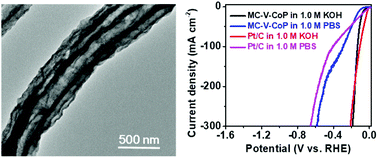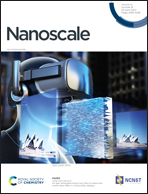Multi-channel V-doped CoP hollow nanofibers as high-performance hydrogen evolution reaction electrocatalysts†
Abstract
Rational design and construction of high-efficiency and low-cost non-noble metal-based electrocatalysts for the hydrogen evolution reaction (HER) is critical for future renewable energy systems. Herein, a multi-channel V-doped CoP (MC-V-CoP) hollow nanofiber is fabricated via electrospinning and a subsequent oxidation/phosphorization process. The formation of a multi-channel hollow structure and V doping can enlarge the exposure of active sites, facilitate the electron transfer and tune the electronic structure of the active sites, resulting in the enhancement of the HER performance. As a result, the MC-V-CoP hollow nanofiber exhibits excellent HER activity with a low overpotential of 65 and 189 mV at 10 and 300 mA cm−2 in alkaline medium, respectively. This is superior to the commercial 20 wt% Pt/C catalyst at a high current density (212 mV at 300 mA cm−2), manifesting its outstanding performance toward the HER at a high current density. In addition, the MC-V-CoP hollow nanofiber also exhibits outstanding HER activity in neutral medium. The proposed strategy for fabricating multi-channel hollow nanofibers can also be used to prepare other transition metal phosphides for advanced electrochemical applications.



 Please wait while we load your content...
Please wait while we load your content...